7 underwater caves that have become global tourism hotspots
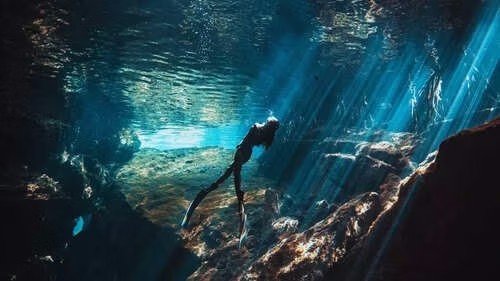
7 underwater caves that have become global tourism hotspots
Underwater caves, always filled with adventure and mystery, are things, which once experienced, will always stay with you. Something is so intriguing about them. While some are accessible to casual visitors via boats or kayaks, others demand professional diving skills and experience. These natural formations, created over thousands of years, offer a chance to witness stunning geological features, crystal-clear waters, and in some cases, ancient mysteries. While not for the faint-hearted, many underwater caves have become popular tourism hotspots, attracting divers from across the globe. How many of these have you been to?
28
The Great Blue Hole, Belize
The Great Blue Hole is easily one of the most iconic dive sites in the world. It is a massive marine sinkhole off the coast of Belize, measuring over 300 metres wide and 124 metres deep, it is renowned for its striking circular shape, visible even from above. Divers come here to explore its limestone formations, stalactites, and marine life.
If the sky is clear, as it often is in Belize, the first thing you will see is an arc of turquoise shining through the surface of the ocean. This is the ridge of the Great Blue Hole, the largest marine sinkhole in the world. It is the ancient remnant of a massive limestone cave that collapsed at the end of the last Ice Age. Today, the shallow ridge is covered in coral and teeming with wildlife from the surrounding Mesoamerican Reef. Meanwhile, the bottom of the Great Blue Hole holds clear remnants of its geological past: ancient stalagmites rising like teeth from the ocean floor.

Belize’s Great Blue Hole stretches nearly a thousand feet across and is a near-perfect circle. The ridge is shallow and covered in a vibrant coral reef.
The stunning visuals, remarkable underwater formations, and dazzling wildlife have made the Great Blue Hole a bucket-list destination for ocean lovers, naturalists, and photographers. Jacques Cousteau helped make the Great Blue Hole famous in the 1970s, and its size still stuns visitors today: nearly 1,000 feet wide and more than 400 feet deep. Yet what many travelers do not realize is that nearby lies Half Moon Caye, a pristine island sanctuary, which offers a complementary experience that includes white sand beaches, excellent snorkeling, and unique birdlife. Together, these two destinations form part of a UNESCO World Heritage Site.
Half Moon Caye is a true Caribbean gem. Loggerhead, hawksbill, and green sea turtles nest along the shore. Iconic birds, like Red-footed Boobies and Magnificent Frigatebirds (which can expand their throats like the gullet of a toad) nest by the thousands. And in the turquoise waters just offshore, coral reefs host schools of tropical fish. An ideal trip to Half Moon Caye might include a canopy walk, relaxation on the beach, and ample time snorkeling.
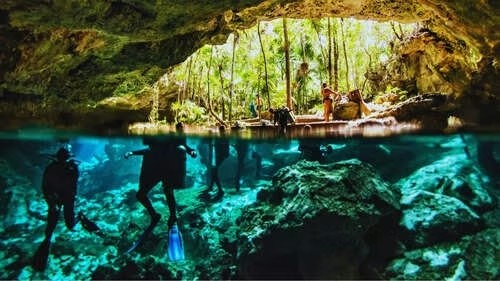
Cenote Dos Ojos, Mexico
Located in the Yucatán Peninsula, Cenote Dos Ojos—meaning “Two Eyes”—is part of one of the world’s largest underwater cave systems. The underwater cave is famous for its crystal-clear visibility and incredible stalactite formations. No wonder, it is a favourite among divers and snorkelers alike.
Cenote Dos Ojos, Mexico: Located on the Yucatán Peninsula, this cenote (a natural sinkhole) is part of a larger underwater cave system. Its name means “Two Eyes,” and it is famous for its exceptionally clear water, which allows divers and snorkelers to see incredible stalactite formations.A pair of connected underwater caves that are part of the Sac Actun cave system, Cenotes Dos Ojos is a popular spot for diving and snorkeling. Sunlight seeping in from the crater above reveals impressive rock formations and makes it easy to see the diverse marine life, including colorful fish and sea turtles. Swimming is also enjoyable in the cenotes, great for younger children, with life jackets available for hire. For the best experience, opt for a guided tour that starts earlier in the day before the crowds arrive and takes you into the deeper parts of the cavern. – Tripadvisor
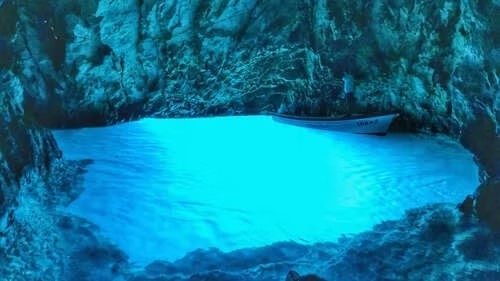
Blue Cave, Croatia
On your trip to Croatia, make sure to include the island of Biševo. Here lies the famous Blue Cave, one of Croatia’s most stunning natural wonders. As sunlight enters the cave through an underwater opening, an ethereal blue glow illuminates the interior, creating an almost magic-like environment. This is not a scuba-diving cave, but visitors can take boat tours
Florida is famous for its freshwater springs and cave diving systems, and the Devil’s Cave System in Ginnie Springs is one of the most popular. The spring’s crystal-clear waters and extensive passageways attract both recreational divers and experienced cave divers seeking adventure.
Modra spilja (The Blue Cave), located in a small cove of Balun on the island of Biševo.The cave itself is 24 meters long, 10–12 meters deep and up to 15 meters high, while the entrance to it measures 1.5 meters high and 2.5 meters wide.In the year 1884. baron Eugene von Ransonnet described and depicted it. On his suggestion the entrance to the cave has been enlarged, making it this way accessible to the entire world. The cave has two entrances: the smaller one artificially widened and deepened so that the boat could sail through, and the wider one, located at the southern part of the cave – the underwater passage, through which the magical game of the light and water is performed…Depending on the season, the ideal moment to visit the cave is between 9 and 13 o’clock in the morning.
58
Devil’s Cave System (Ginnie Springs), Florida, USA
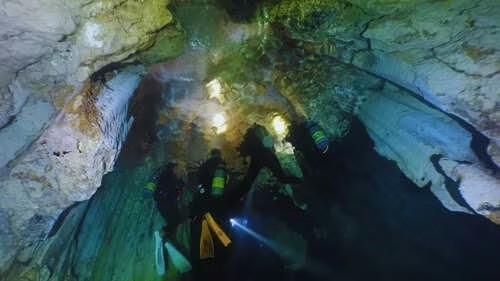
Chandelier Cave, Palau
This underwater cave gets its name from the beautiful stalactites hanging like chandeliers. This is one of the most popular diving sites in Palau. For die-hard divers, the cave’s chambers and the limestone formations are simply irresistible. The air pockets inside the cave provide the necessary break from diving. Have you tried this out yet?
The Pacific state of Palau is an archipelago consisting of more than three hundred islands. The largest of them occupies 374.1 km² or 70% of the area of the entire country. The rest of the islands can be very tiny, but one of them is known to divers from all over the world. Under the island of Ngarol, which cannot even be seen on a regular map, there is a stunning underwater cave named Chandelier.
It appeared many centuries ago: rainwater constantly seeped through the limestone that forms the surface of the island and the result of erosion was cavities filled with air. After the last ice age, the water level rose, and this is how a cave system consisting of five chambers appeared. Four are filled with water, and the last one, the smallest, is land.

The locals call the cave “Iiel Temekai” meaning “The cave of Sebastes”. Perhaps, many fish used to live here, but since then the main attraction has changed. For divers, this place is called “Chandelier cave”. The calcined water created stalactites and other limestone formations. They have taken on a variety of forms, and if you apply your imagination, the clusters can resemble lighting appliances. “Chandelier” is the official term for this kind of stalactite, but here the outgrowths are so picturesque that they gave the name to the whole cave.
The entrance to this amazing underwater world is at a depth of about 4.5 meters, and the diver immediately plunges into a parallel reality. Stalactites cover the walls not only above the water, but also below its surface too, and every candelabrum is unlike any other.
Having dived into the first chamber, you can swim to the very last one without haste, rising above the water and viewing these wonders of nature from all sides. Even the passageways between the chambers are full of fantastic figures!

In each chamber between the surface of the water and the stalactites hanging from above, there is an air space ranging from half a meter to several meters. Depending on high and low tide, the height of the air chamber can change by about 1-2 meters. While visiting this place in the morning and returning in the afternoon, you may simply not recognize it! Some air chambers are quite small in size, so you can barely stick your head out of the water and look around, while others can resemble a moderate room. Among the guides, this kind of entertainment is popular: swim up to the stalactite and lick with your tongue a drop of freshwater that has seeped through the thickness of the earth.
A distinctive feature of this place is the easy access: the cave is located 5-10 minutes by boat from the diving centres located on the island of Malakal near the tourist capital of the country, the city of Koror.

It is better to enter the cave when there are no groups of divers: then you can enjoy exploring the fantastic natural formations alone.
In the fourth, the last and smallest chamber of the cave, there is a small inconspicuous hole in the wall, located about a meter above the water. This is a little-known passage to the fifth chamber, overland. To visit this hall, you will need to first undress in the water, take off the cylinders, fins, masks, take a flashlight, climb the wall, and then crawl through this narrow hole several meters through the mud. And after that, another cave will open at the exit, but this one without water.

The air here is stale and it is rather difficult to breathe, but still, it is possible. And as compensation for all the suffering, you will see a small beautiful chamber with stalactites and stalagmites. The impression of the image of the discoverer will only be spoiled by the “Vasya was here” inscriptions written in different languages.
The process of removing equipment and crawling along a narrow hole is time-consuming, especially considering that afterwards all this must be done in the reverse order, and there is not much space. Therefore, the fifth hall can only be accessed by a small group, so it is better to take a private guide. Due to the complexity of the equipment delivery and the limited time, we did not take pictures in the fifth hall.
And seen from above, the island looks like a beautiful green oasis in the middle of the endless ocean, and there is no sign of what kind of treasure is under its surface.
El Cenote Angelita, Mexico
Want to see a river underwater? Confused? Another stunning cenote in Mexico, Angelita is famous for its unique hydrogen sulfate layer that creates the illusion of a river flowing underwater. Diving here is an eerie yet mesmerising experience, as divers pass through clear waters before entering the surreal “river” cloud.
Confused? Another stunning cenote in Mexico, Angelita is famous for its unique hydrogen sulfate layer that creates the illusion of a river flowing underwater. Diving here is an eerie yet mesmerising experience, as divers pass through clear waters before entering the surreal “river” cloud.
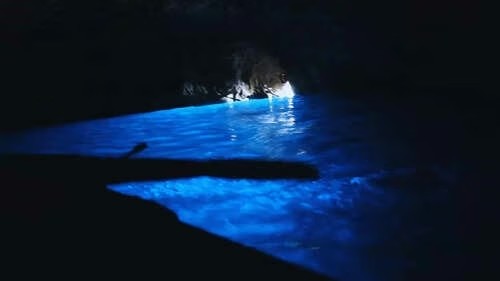
Capri Blue Grotto, Italy
The Blue Grotto of Capri is one of Italy’s most famous attractions. Looks otherworldly? You bet it does. This underwater cave is accessible by small boats only. Swimming is restricted here to preserve the beauty of the cave. The otherworldly blue light inside the cave is caused by sunlight passing through an underwater cavity. This cave needs to be in every visitor’s to-do list, the experience is unforgettable.
Globally, many underwater caves have become major tourist attractions, drawing visitors with their unique geology and clear waters. Some are accessible to snorkelers and casual boat tours, while others are destinations for experienced cave divers.
Capri Blue Grotto, Italy: One of Italy’s most famous natural attractions, this sea cave is accessed via small rowboats that pass through a tiny entrance. The brilliant blue light inside is the result of sunlight entering through an underwater cavity.
Where Are the Natural Wonders Found Under the Sea?
Our oceans are home to some of the most amazing natural wonders on Earth. These underwater wonders range from intricate coral reefs and massive underwater caves to deep sea trenches and unique geological formations. Below, we explore some of the most fascinating and record-breaking natural wonders found beneath the sea.
Underwater Coral Reefs
Coral reefs are one of the most biodiverse ecosystems in the world, hosting a huge variety of marine life. These vibrant ecosystems are often referred to as the “rainforests of the sea” and are home to a vast array of fish, invertebrates, and marine mammals.
1. Great Barrier Reef (Australia)
The Great Barrier Reef is the largest coral reef system in the world, located off the coast of Queensland, Australia.
- Size: 344,400 square kilometers (133,000 square miles).
- Fun Fact: The reef is visible from space and is home to over 1,500 species of fish and 400 species of coral.
- Significance: It is one of the most biodiverse ecosystems on Earth and a UNESCO World Heritage Site.
2. Belize Barrier Reef (Belize)
The Belize Barrier Reef is the second-largest barrier reef system in the world, located off the coast of Belize in Central America.
- Size: 96,300 square kilometers (37,000 square miles).
- Fun Fact: The reef is home to the famous Blue Hole, a giant marine sinkhole that is a popular dive site.
- Significance: It is a UNESCO World Heritage Site and a major tourist attraction for divers and snorkelers.
3. Red Sea Coral Reef (Egypt, Saudi Arabia, Sudan, Eritrea)
The Red Sea Coral Reef stretches across the coastlines of Egypt, Saudi Arabia, Sudan, and Eritrea, making it one of the largest and most biodiverse coral reef systems in the world.
- Size: Over 1,240 kilometers (770 miles) long.
- Fun Fact: The reef is home to over 1,200 species of marine animals and 250 species of coral.
- Significance: It is known for its clear waters, warm temperatures, and unique marine life.
Underwater Caves
Underwater caves are fascinating geological formations that are often only accessible to experienced divers and explorers. These caves can be found in regions around the world and are often home to unique ecosystems and mineral formations.
1. The Blue Hole (Belize)
The Blue Hole is a giant marine sinkhole located off the coast of Belize. It is famous for its crystal-clear waters and incredible underwater formations.
- Depth: 124 meters (407 feet).
- Fun Fact: The Blue Hole is considered one of the top diving sites in the world due to its visibility and unique underwater structures, including stalactites and stalagmites.
- Significance: It is part of the Belize Barrier Reef Reserve System, a UNESCO World Heritage Site.
2. Cave of Swallows (Mexico)
The Cave of Swallows, or Cueva de las Golondrinas, is one of the largest vertical caves in the world, located in San Luis Potosi, Mexico.
- Depth: 370 meters (1,214 feet).
- Fun Fact: The cave is a popular spot for base jumping, as it has a vast open space that allows jumpers to freefall before deploying their parachutes.
- Significance: The cave is also home to thousands of birds, particularly the barn swallow, which is why it’s called the Cave of Swallows.
Underwater Volcanoes
Underwater volcanoes are a natural phenomenon that occurs when molten rock from beneath the Earth’s crust erupts under the sea. These volcanoes can create new landforms and are important for the geological processes that shape the Earth.
1. The Loihi Seamount (Hawaii, United States)
The Loihi Seamount is an underwater volcano located off the coast of the Big Island of Hawaii.
- Height: 3,000 meters (9,843 feet) from the ocean floor.
- Fun Fact: Loihi is the newest volcano in the Hawaiian hotspot and is expected to eventually emerge as a new island.
- Significance: It is an active underwater volcano that continuously reshapes the ocean floor.
2. Mount Tamu Massif (Pacific Ocean)
Mount Tamu Massif is the largest underwater volcano in the world, located in the Pacific Ocean, east of Japan.
- Size: It covers an area of approximately 310,000 square kilometers (120,000 square miles).
- Fun Fact: Mount Tamu Massif is so large that it is classified as a “shield volcano,” similar to the famous volcanoes of Hawaii.
- Significance: It is considered the largest known volcano on Earth when measured by its surface area.
Underwater Trenches
Ocean trenches are deep underwater valleys formed by tectonic activity. These trenches represent some of the deepest parts of the ocean and are home to unique marine life and geological phenomena.
1. Mariana Trench (Pacific Ocean)
The Mariana Trench is the deepest part of the world’s oceans and the deepest point on Earth.
- Depth: 10,994 meters (36,070 feet) at the Challenger Deep, the deepest point in the trench.
- Fun Fact: The Mariana Trench is located in the western Pacific Ocean and is so deep that Mount Everest could easily fit inside it with over 2 kilometers to spare.
- Significance: The trench is a key area for scientific research into oceanography and deep-sea ecosystems.
2. Tonga Trench (South Pacific Ocean)
The Tonga Trench is another deep ocean trench, located to the east of the islands of Tonga in the South Pacific Ocean.